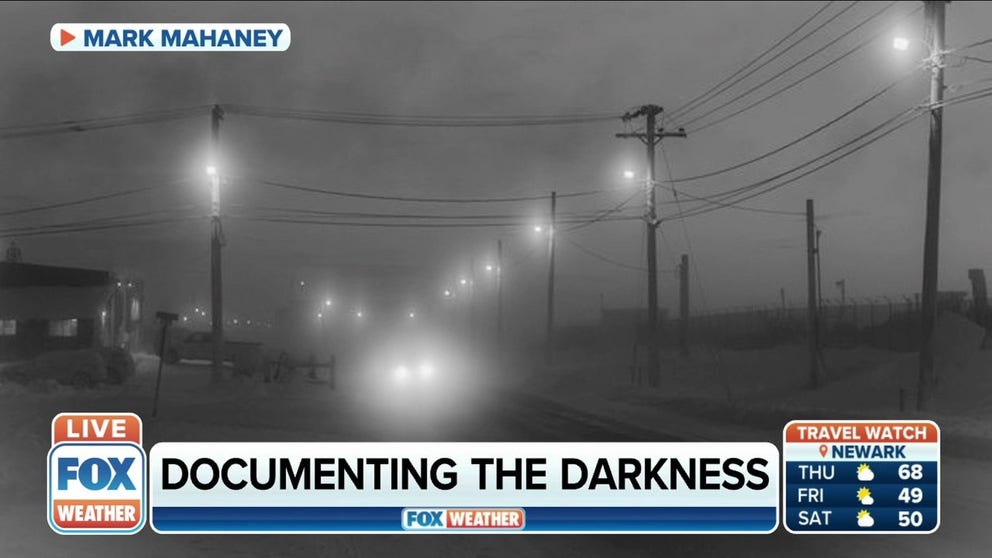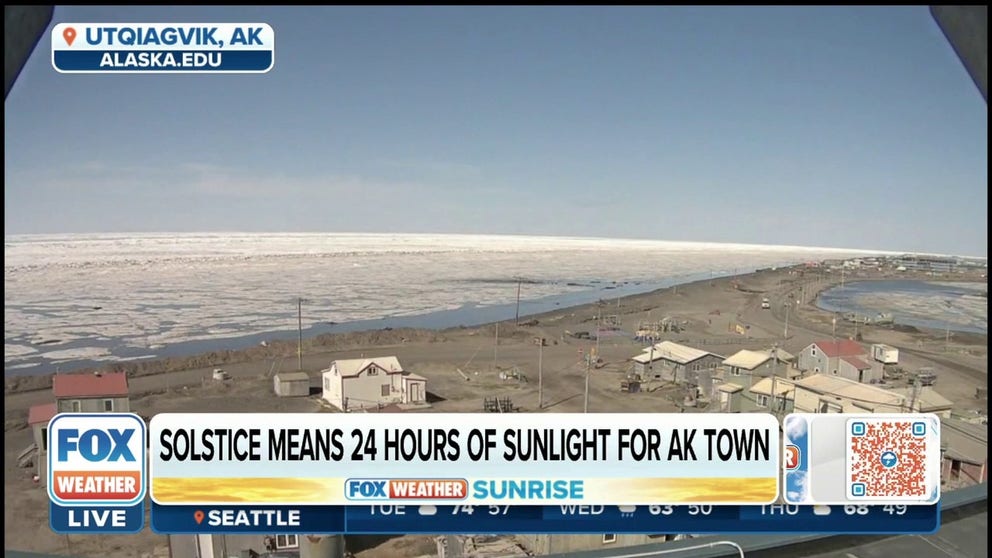How do Alaskans cope with nearly all-day darkness in winter, all-night daylight in summer?
Alaskans love the long days of summer, but winter darkness tends to have a negative effect on people
Capturing Alaska's polar night
Photographer Mark Mahaney ( from California) traveled to Utqiagvik, Alaksa in 2019 to capture the final days of the season’s polar night. He documented the darkness for 12 days.
Imagine sitting in your office or the classroom in the middle of the day, and you look out the window and the street lights are on because it’s practically dark. Or maybe it’s midnight and you’re trying to sleep, but all you can do is lie awake in your bed because sunlight is shining brightly through your window.
Welcome to Alaska.
For about two months surrounding December’s winter solstice, the sun barely peeks above the horizon in Alaska. In fact, the northernmost city in America – Utqiaġvik, Alaska, formerly known as Barrow – has near-constant darkness from mid- to late November until late January because the sun never rises during that 60-plus-day period.
64 DAYS OF NIGHT: ALASKA TOWN WON'T SEE THE SUN UNTIL JANUARY
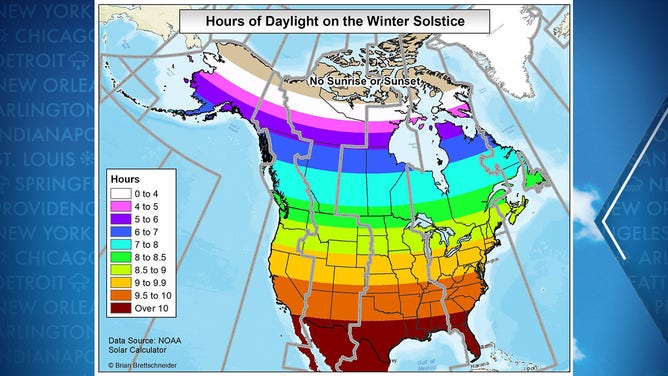
Hours of daylight (sunrise to sunset) on the winter solstice.
(Dr. Brian Brettschneider)
But in the months surrounding June’s summer solstice, the sun barely slips below the horizon in Alaska, so darkness never fully sets in – think of it like dusk that extends all the way through dawn.
And residents of Utqiaġvik don’t even see a sunset for more than 80 days from early to mid-May until early August, so it’s probably not the best destination for a Fourth of July vacation if you’re hoping to watch a nighttime fireworks display.
Summer solstice means 24 hours of sunlight for Alaska town
The summer solstice means 24 hours of sunlight for Utqiagvik, Alaska.
Early summer in Alaska
In Anchorage, Alaska, on the summer solstice – the longest day of the year – the sun rises at 4:20 a.m. and sets at 11:42 p.m.
Now you might be wondering how this translates to 24 hours of daylight when the sun is below the horizon for 4 hours and 38 minutes.

The sun is still above the horizon at midnight on the summer solstice, as viewed from the summit of Flattop Mountain just east of Anchorage, Alaska.
(Dr. Brian Brettschneider)
"During our ‘night’ period on the summer solstice, the darkest we get is civil twilight, which is the lightest form of twilight," said Eric Drewitz, a meteorologist and the Assistant Science and Operations Officer at the National Weather Service office in Anchorage, Alaska.
WHY YOUR SUNSET CHART LOOKS WRONG, EVEN THOUGH IT ISN'T
Civil twilight is when the sun is less than 6 degrees below the horizon. There is also nautical twilight, which is when the sun is between 6 and 12 degrees below the horizon, and astronomical twilight, with the sun between 12 and 18 degrees below the horizon. Night officially sets in when the sun falls 18 degrees or more below the horizon.
"During the summer solstice, the sun is approximately 5 degrees below the horizon at solar midnight," Drewitz said.
At solar noon, when the sun reaches its highest point of the day, the sun angle in Anchorage only reaches 52.3 degrees above the horizon on the summer solstice, which is significantly lower in the sky than in the Lower 48 states. Drewitz noted that’s equivalent to the solar-noon sun angle in New York City on March 27-28 and Sept. 14-15, near the vernal (spring) and autumnal equinoxes, respectively. The sun angle reaches as high as 72.7 degrees in the Big Apple on the first day of summer, some 20 degrees higher in the sky than in Anchorage.

Hours of daylight (sunrise to sunset) on the summer solstice.
(Dr. Brian Brettschneider)
Even though Alaskan summers are relatively cool compared to what most people are accustomed to in June, July and August, indoor temperatures can get uncomfortably warm due to the lower sun angle. This is because when the sun is lower in the sky, its energy is spread out over a larger surface area. That, combined with more than 19 hours of sunlight during the day, causes homes to heat up like ovens.
UNITED STATES ENDURED HOTTEST SUMMER ON RECORD IN 2021, NOAA SAYS
"Alaskan architecture is very insulating due to our cold winters. Therefore, in the summers, it gets hot inside," Drewitz said. "When it is 65 degrees outside, it is 85 in my apartment, and thus, a portable air conditioner is highly recommended for the summer months."
Early winter in Alaska
On the winter solstice – the shortest day of the year – the sun rises at 10:14 a.m. in Anchorage and sets not even 5.5 hours later at 3:41 p.m.
The solar-noon sun angle? Only 5.5 degrees above the horizon.
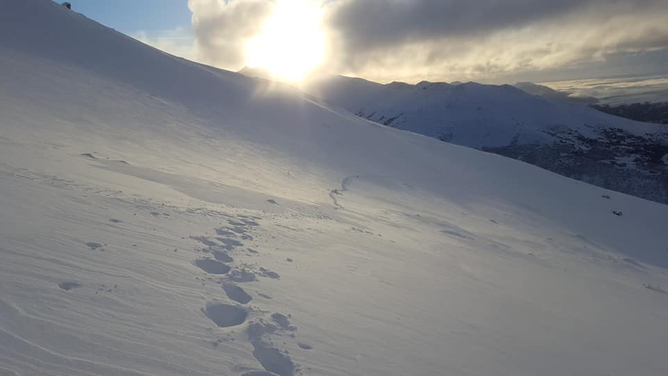
The sun is barely above the horizon at noon on the winter solstice, as viewed from Flattop Mountain just east of Anchorage, Alaska.
(Dr. Brian Brettschneider)
"When the maximum solar-noon sun angle is 5 degrees above the horizon or less, the sun provides no thermal heating for the day," Drewitz said.
No wonder winters are so cold in America’s 49th state.
For comparison, New York City sees a 25.9-degree sun angle at midday on the first day of winter, with a less-depressing 9 hours and 15 minutes of daylight. In fact, just 40 minutes after sunrise, the sun is already higher in the sky in the Big Apple than it is all day in Anchorage.
How Alaskans deal with drastic seasonal changes in daylight
"In the summer, Alaskans like to have blackout curtains and sleeping masks," Drewitz said. "They help keep the room dark."
The only problem is, since indoor temperatures can get so warm in the summer, you need some airflow from the outdoors to make it more bearable if you don’t have air conditioning.
"Yes, blackout curtains are essential for many people," said Dr. Brian Brettschneider, an Alaska-based climatologist. "Although on warm days, you need to keep windows open and fans running to cool the house at night – which means no curtains."
In general, though, most Alaskans really enjoy the long days of summer. And why wouldn’t they?
"Alaskans almost universally love the long days of summer. Imagine going fishing at midnight, or playing basketball at 11 p.m., or a hiking traverse through the middle of the night?" Brettschneider said. "The only complaints you'll hear are about it not lasting long enough."
Winter, on the other hand, is a different story. Although Alaskans typically aren’t bothered by snow or very cold temperatures, the wintertime darkness is difficult to cope with every year.
"Winter darkness does tend to have a negative effect on a number of people," Brettschneider explained. "In the cities, the reflection of street lights off the snow cover makes a tremendous difference in the psyche of residents."
HOW TO RECOGNIZE SEASONAL AFFECTIVE DISORDER AS WINTER APPROACHES
Drewitz said taking vitamin D is highly important in the winter because the human body produces less of it when it’s not exposed to enough sunlight. This is especially true in northern areas of Alaska such as Utqiaġvik, where civil twilight is the lightest it gets for some 60 days since the sun doesn’t rise above the horizon from mid- to late November until late January.
Some people use happy lights – also known as light-therapy lamps – to help brighten the mood on a cold, dark winter’s day, Drewitz added, noting that the early evening can often feel like midnight because it has been dark for so long already.
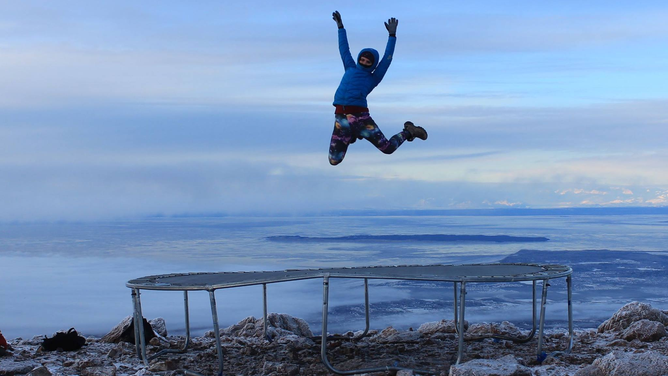
The sun is barely above the horizon at noon on the winter solstice, as viewed from the summit of Flattop Mountain just east of Anchorage, Alaska.
(Dr. Brian Brettschneider)
"Very few people celebrate the shortness of the days (daylight) in winter and instead count the days until ‘normal’ daylight returns," said Brettschneider.
Speaking of that, fall and spring in Alaska are the most similar to the rest of the United States in terms of daylight, so there are a couple of periods each year when Alaska’s days are a "normal" length.
"On the equinoxes, everywhere on Earth experiences 12 hours of daylight and 12 hours of darkness," Drewitz said. "Due to that, our sunrise and sunset times are normal like the Lower 48."
WHY FALL SHOULD ACTUALLY BEGIN ON SEPTEMBER 1
It should be noted, however, that the amount of daylight dramatically increases from day to day near the first day of spring and drastically decreases each day near the first day of fall. Utqiaġvik gains about 9 minutes of daylight every day in March, while the days each shorten by about 9 minutes in September.
"I've been through a few fall and spring transition seasons now, and the only word I can come up with to describe the rapid day-to-day daylight changes is: wild," said Luke Culver, a meteorologist at the NWS office in Fairbanks, Alaska. "During this time, you gain/lose ... almost an hour of daylight per week. Imagine going to work Monday morning and the sun is rising, and at the same time the following Monday morning, the sun has already been up for an hour."
Culver added that having a watch during the fall and spring is crucial because you can't rely on the sun to figure out what time it is.
"Most people up here say we have two seasons: winter and summer," Culver said. "Spring and fall are very short and feel like they last only a week or two."
